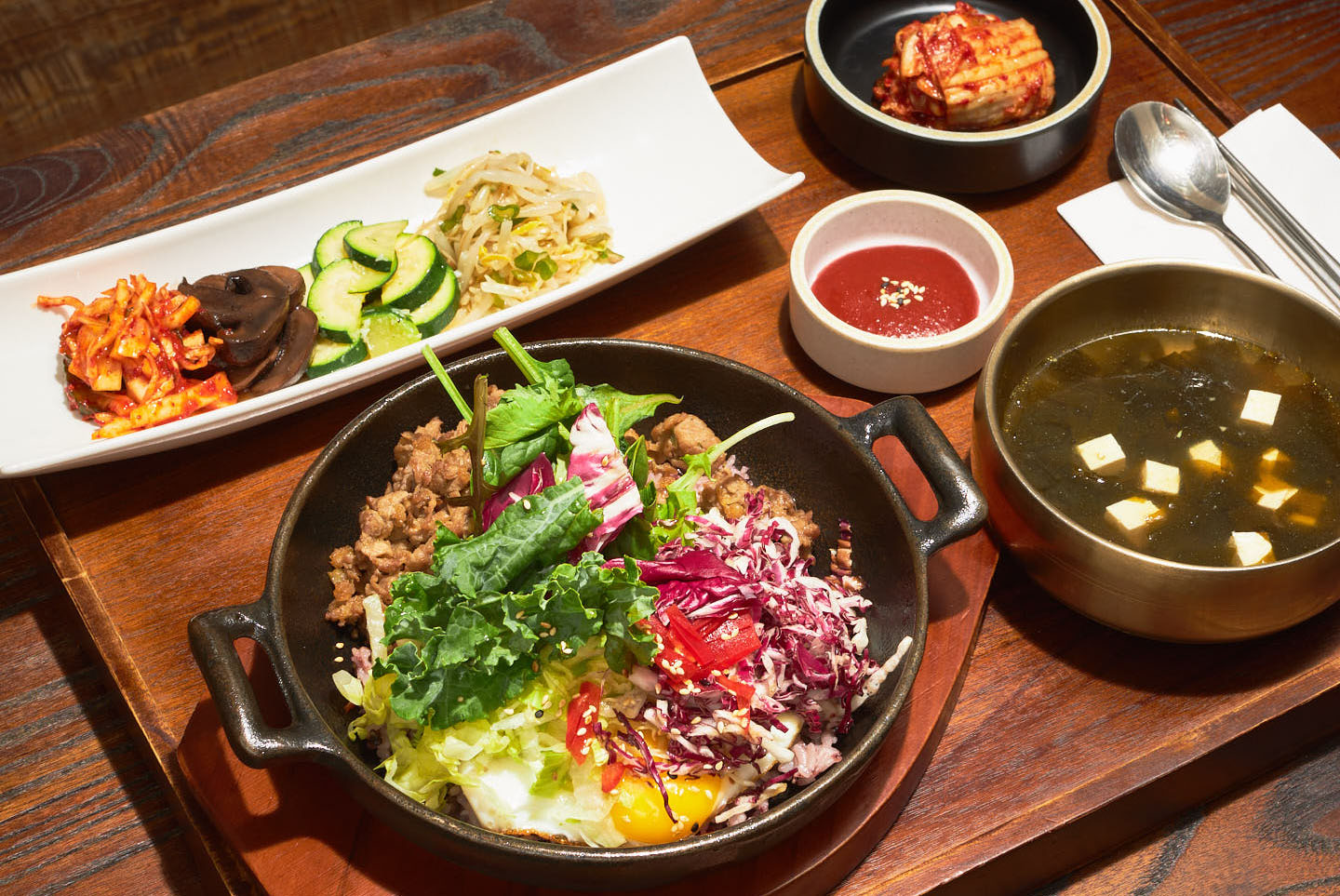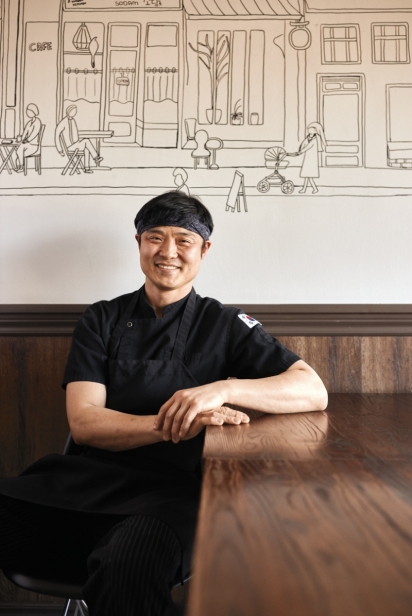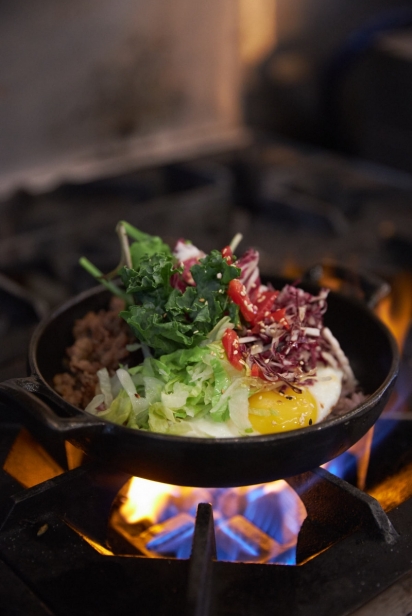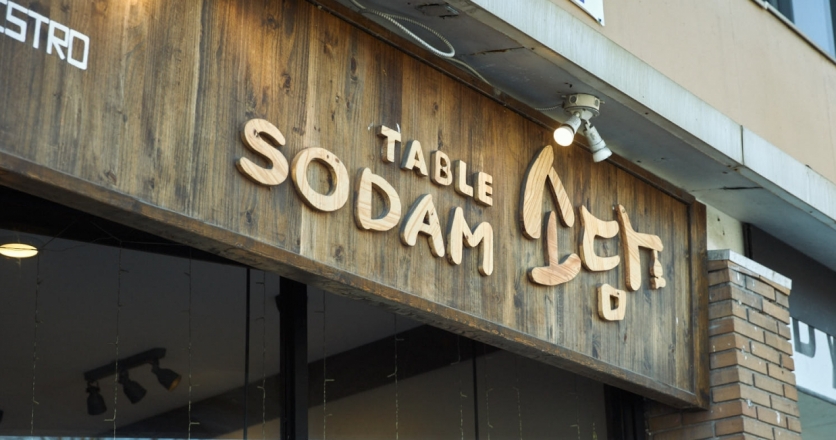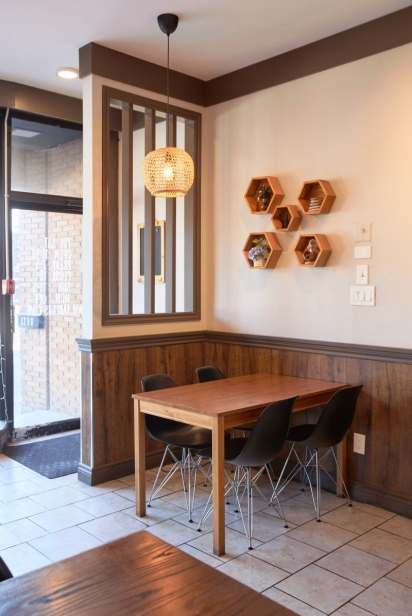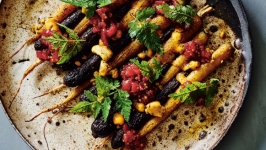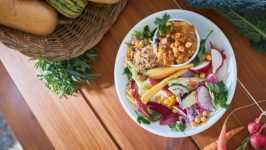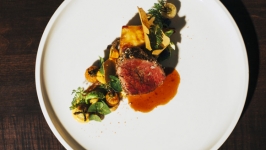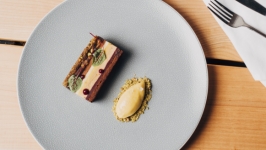'It's a Hard Life, But I Enjoy It'
Kunwoo “Sean” Nam had dreamed of working in the kitchen since he was seven years old. Now, the determined Korean immigrant works night and day in a kitchen following that dream.
And that was before the pandemic, which stopped and restarted his dream several times over the course of two years. But Nam is a survivor and, with the help of his wife, Sunghwa Lee, as well as some loyal patrons, many of them his fellow business owners in Old Ottawa South, he managed to keep the lights on and remain in business through the uncertainty.
Nam on a plate
Asked to produce a dish that represents himself and his approach to cooking, Nam presents a traditional Korean tray of food. A bibimbap sizzles in a cast iron serving dish, and includes a combination of black and Calrose rice, red cabbage, kale, mixed greens, red peppers and the ever-present fried egg nestled into one side. The meat is beef bulgogi, thinly sliced and amped up with a sweet-savoury taste. Umami-rich gochuchang sauce, which he imports from Korea and then doctors up a bit, sits in a dish on the side.
But that’s not all. Koreans are known for banshan, the name for the tiny side dishes that come with most Korean restaurant meals. This one is no exception. Served on a narrowly rectangular plate is a quartet of spicy cabbage, roasted mushrooms, pickled cucumbers and bean sprouts. Kimchi — Korea’s universally loved condiment, this one homemade by Nam — has its own bowl on the platter, as does the soup of the day. The day edible visited, it was a clear broth, made rich with dried anchovy, that he augmented by seaweed and tofu.
“Mostly, I want to make something different than other common restaurant dishes,” Nam says, which might explain why his menu has plenty of traditional fare, some of which is served with implausible Western sides such as fettucine Alfredo. “I focus on presentation.”
Traditionally, Korean side dishes are shared among diners at the table, but Nam deviates on that, too. He wants each diner to have a personal serving, partly to set his restaurant apart and partly to cater to diners’ more cautious approach to sharing in a pandemic.
“I want to make people their own side dishes,” he says. “We can do it for sharing, too, if there’s a family that wants to share.”
Standing at his side in the modest eatery at 1200 Bank St. is his wife, who he says watches food trends and suggests ideas. She’s the chef’s muse, the mother of his three sons, the restaurant’s bookkeeper and an occasional server.
The road to Sodam
Nam was born in Seoul and went to culinary school there in 1995, learning traditional Korean cooking immediately upon graduation from high school. Then, he did 26 months of compulsory military service, something the democratic nation has demanded from its male citizens since 1957, four years after an armistice was reached between North and South Korea. The goal is to keep a ready fighting force should North Korea attack.
After completing his military training, he did some work as a bodyguard in a few capacities, including for the president of Hyundai. Then, he embarked on his culinary career, first working as a baker and then joining the kitchen at the Lotte Hotel.
“Then, I thought I was at a good age to have another experience so I decided to try to do a working holiday.
“I didn’t think about studying, but then I got some information about the Cordon Bleu,” he says. “I thought, ‘I can work anytime, maybe I’ll study this time.’ I worked a lot to save for the tuition fees. Finally, I got there and took the course.”
After returning to Korea, he found a job at the Intercontinental Hotel.
“Since I was in Grade 8, I always thought if I became a chef or cook, I wanted to work at that hotel,” he says. “So I kept visiting human resources every month and eventually, I told them ‘I’m going to come until you hire me.’”
After the third time he showed up, they did hire him and he remained there for four years.
“I worked the buffet section,” he says. “There were 12 restaurants in the hotel. Because my training was Cordon Bleu, I would cook steak, pasta and salad.”
So how does one go from working in a hotel in Seoul to living in Ottawa? By this point, he had met his wife, who wanted to learn English and, because her sister was studying English in Ottawa, she chose to come here, too. It was initially supposed to be a study trip just for her, but when she got pregnant before leaving for Canada, Nam insisted he come, too. His skills were transferrable after all.
Ottawa adventures
Nam pursued more culinary studies at Algonquin College once he landed in Ottawa. Because of his previous training and experience, he was allowed to skip the first year of the two- year program. After he graduated, he got a job in the catering department at Algonquin College.
His job was full-time, with good benefits, but he wanted to work for himself and share his culture with Ottawans. He weighed the decision heavily and then decided to jump into his own operation. To learn the ropes, he took a job in a small cafeteria in the Corel Centre and studied how to run a small business while on the job.
“At that time, Korean food and culture started [ramping] up [worldwide,]” he says. “We decided to open.”
That was 2015. When they moved to Canada in 2006, few people even knew where Korea was, but by that time, K-pop and Korean film were becoming popular and the timing seemed right to open Table 85 Café & Catering. He and Lee settled on a non-descript real estate office building on Bronson Street, just south of the Queensway, across from Drummond’s gas station.
They occupied a cafeteria in the building and started off serving standard Western fare — salads, burgers, the odd Tex-Mex dish — with a few Korean dishes thrown in. But after letting friends and family know they had Korean food on the menu, all of their customers started gravitating to those dishes and soon they had an evening crowd frequenting their humble cafeteria-like venue.
“The people who worked in the building were surprised,” he says with a laugh, adding that black bean noodles, known as jajangmyeon, were one of his most popular dishes. “Everyone loves them.”
A flip through the photos of the now-closed Table 85’s Facebook feed shows that even in the beginning, the cafeteria dishes Nam was making were clearly the work of a trained chef and not a cook who learned on the job.
The couple ran both places for a year, with Nam working 16- to 20-hour days and formally closed Table 85 in February 2020 to concentrate on Table Sodam. Table 85 was also the hub for catering jobs, which gave Nam and his food visibility. He was invited to cater a party at Prime Minister Justin Trudeau’s residence and has the photos to prove it. He also catered events for the Korean Embassy and the Korean Cultural Centre as well as weddings and other events.
In his signoff message on Table 85’s Facebook page, he mentions that at one point, he worked 64 hours straight, and signs it “Sean, hard worker for Table 85 customers.”
Table Sodam
Today, Lee and Nam have three sons, a 15-year-old and 12-year- old twins. When the twins turned six, Lee finished her business studies in accounting at Algonquin College, allowing her to do the bookkeeping for the restaurant.
Table Sodam is in a narrow space, formerly occupied by a Latin American restaurant. It seats 24 and one full wall features a charming line drawing, done by Lee, of the Bank streetscape it occupies.
Nam says the menu is about 50 per cent traditional and 50 per cent Korea-inspired fusion. He knows how to cook Korean food, and with his extensive French training, he also knows how to cook plenty of other cuisines. That’s why Alfredo comes as a side with his boneless chicken and why a creamy cheese sauce comes with his duo of fried chicken, half with a sweet and spicy coating, the other half with a sweet soy sauce. The fried chicken dishes with the non-Korean sides are the most popular items on the menu, though Korean customers gravitate more toward the traditional offerings, such as bibimbap and bulgogi.
Devotion to the trade
“It’s a hard life, but I enjoy it,” Nam says.
And he was raised by hard workers. At 83, his father is still working, as the superintendent of a building in Seoul. He actually worked two jobs until the pandemic hit. His mother is 82 and he hasn’t seen either of them for several years. He last saw his mother when she visited Ottawa five years ago. It’s been longer since he’s seen his father.
The pandemic has kept them apart, and has also slowed business.
“We had planned on opening another location,” he says, but those plans were put on hold when COVID hit and business ground to a halt.
“It’s getting better now, but now it’s very hard to find staff,” he says, adding that some of his former staff members returned to Korea.
“[The pandemic] was very hard, tough and depressing,” Nam says, adding that he’s thankful for the community and his neighbouring businesses in Old Ottawa South that banded together to support him.
Table Sodam
1200 Bank St., Ottawa, Ont.
table85.com | 613.421.1229


